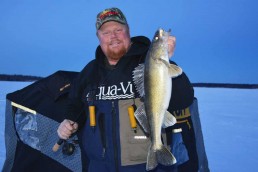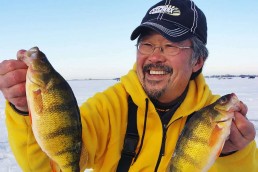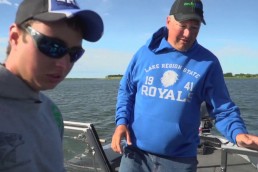Contact Points Key for Early-ice Walleye Action
SHARE THIS POST
Walking out on the ice early in the season is something avid anglers look forward to all year. The first couple of times there is an element of uncertainty about the ice conditions, which can take the fun out of the experience.
My first time on the ice is usually around Thanksgiving. All I’m trying to do at that point is catch something big enough for photos so I have some fresh material for the start of the winter “Bro Road Show.”
Early-ice walleyes
Walleyes are a favorite fish to pursue, both in summer and winter. Before anglers can successfully target them, you need to know a little more about their behavior and what they like to do.
Walleyes have tails and fins, and they know how to use them. This fish likes to travel in schools and they make distinct feeding movements when they get hungry, going one place to feed and another place to rest when they are done.
This species uses “contact points” when they access most structures, like sign posts on roads, to help them get where they’re going. It’s like the door on a grocery store, where shoppers come in the front door, spread out to find what they want to eat and leave back through the doors when they go back home. Walleyes often head toward the deepest water close to their feeding areas when they leave the structure. Anglers are trying to find contacts points where the walleyes pass by when they move between these feeding and resting areas.
Contact points can take many forms. These could be logs on the bottom, a finger of rocks in a patch of sand, a few big boulders, a distinct tip on a point, a steep inside turn, a heavy patch of weeds next to a drop-off or a neck-down area that forms a saddle between structures.
Sometimes you need to see what the area looks like with your own eyes to figure out a good place to set up your house. This is easy to do with an Aqua-Vu Micro 5, as it’s small enough to fit in your pocket.
Anglers need to figure out where the walleyes are going to be located at a predictable time and place. That way they can be set up and waiting for the walleyes when they get active.
I use a two-pronged approach to help me consistently catch them and stay on active fish. I like to have a go-to spot where I am pretty certain walleyes will show up during prime time. I’ll pick a spot and set up a base camp, using a Frabill Bro Hub. Then, I may use a Bro-Series Side-Step house if I find some active fish in another location during the day.
Timing the bite
Stained lakes often have a better day-bite for walleyes than lakes with clear water. If I am fishing on Lake of the Woods, I’ll set up for walleyes along structure in the mornings and evenings, and then move out to the mud flats for saugers and suspended walleyes during the day.
Are you enjoying this post?
You can be among the first to get the latest info on where to go, what to use and how to use it!
Perch are a good complementary species for walleyes on many clear lakes. Anglers can fish for walleyes during low-light periods on structure and then for perch during the day on the deep or shallow flats.
The reputation of the lake also enters into the equation. Lakes like Upper Red Lake can have a good day- bite for walleyes because of the stained water. Once walleyes stop biting in the morning on the shoreline break, I will keep moving farther from shore until I find another active school of walleyes.
Clear-water lakes can also have a shallow-water pattern for walleyes that is good in the mornings and evenings and then a deep-water pattern on mid-lake structure during the day.
Different depths go through low-light periods at different times of day. The shallows go through low light early and late in the day, while deep water goes through low light toward the middle of the day. The angle of the sun has to be more directly overhead to penetrate through the ice and snow and reach structures located in deeper water.
Gearing up
Once anglers have some walleyes located, they still have to figure out how to catch them. Walleyes can be finicky, but they usually have a split personality. Sometimes walleyes want a subtle presentation, while other times they may prefer more aggressive presentations.
When it comes to rods for walleyes, I like to use different length rods for different situations. I use Frabill Bro-Series Rods in 28, 30 and 32 inches in length for walleyes. I use rods with medium-light to medium-heavy action, depending on what depth and what weight lure I am using.
I usually have an Original Buck-Shot Rattle Spoon on one rod and a Buck-Shot Flutter Spoon on another rod. Then I may have a Puppet Minnow rod or a lighter rod rigged with a Bro Bling Jig to use with a minnow for the more finicky walleyes.
Walleyes have excellent eyesight, so the color of lure is usually important. I like gold, orange, pink or glow lures in stained water lakes, and prefer green, blue, silver, gold and copper lures in clear-water lakes.
Winter is the longest season of the year in northern Minnesota, so get ready for some serious ice fishing. I hope to see everyone on the “Bro Road Show” this winter, so watch my Facebook page for the latest details of when I am coming to a store near you.
MWO
SHARE THIS POST
Did you enjoy this post?
You can be among the first to get the latest info on where to go, what to use and how to use it!
Brian 'Bro' Brosdahl
Outdoor communicator Brian “Bro” Brosdahl lives in northern Minnesota. He is a walleye guide in the Cass Lake, Leech Lake and Lake Winnibigoshish areas. He is sponsored by Northland Fishing Tackle, Frabill/Plano, Aqua-Vu, Humminbird/Minn Kota, St. Croix Rods, Ranger Boats, and Evinrude. Guide inquiries: brosguideservice.com. Follow on social media.



